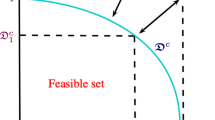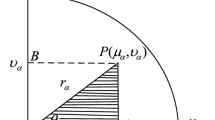Abstract
Fuzzy ranking plays a vital role in decision-making problems and various fuzzy applications. There are plenty of ranking methods that are used to rank fuzzy numbers. However, they fail to give satisfactory results in certain situations due to the complexity of the problem. In this present study, an attempt has been made to introduce four types of ranking methods in the field of intuitionistic dense fuzzy (IDF) depending on centroid and graded mean ranking. Also, arithmetic operations based on \(\lambda _1, \lambda _2\)-cuts, fuzzy numbers, and extension principles are defined for IDF environment. A model is framed to rank MCDM problems, which are aggregated using a weighted aggregation operator and ordered using the proposed and extended ranking methods. To illustrate the proposed MCDM model under the field of IDF, the problem of robot selection is taken for war fighter robots and exoskeleton robots to help and replace humans in war and help assistive walking patients with spinal cord injuries. The result reveals that the Ripsaw and Rewalk emerge as preferable options for substituting humans in the contexts of war fighters and exoskeleton robots, respectively. To analyze the effectiveness of the ranking results, comparative and sensitivity analyses are examined. Thus, the results provide a satisfactory output.





Similar content being viewed by others
Data Availability
The authors confirm that the data and material supporting the findings of this work are available within the article.
Code Availability
Not applicable.
References
Swethaa, S., Felix, A.: An intuitionistic dense fuzzy AHP-TOPSIS method for military robot selection. J. Intell. Fuzzy Syst. 44(4), 6749–6774 (2023)
Sampathkumar, S., Augustin, F., Kaabar, M.K., Yue, X.G.: An integrated intuitionistic dense fuzzy Entropy-COPRAS-WASPAS approach for manufacturing robot selection. Adv. Mech. Eng. 15(3), 16878132231160264 (2023)
Kang, D., Devi, S.A., Felix, A., Narayanamoorthy, S., Kalaiselvan, S., Balaenu, D., Ahmadian, A.: Intuitionistic fuzzy MAUT-BW Delphi method for medication service robot selection during COVID-19. Oper. Res. Perspect. 9, 100258 (2022)
Bustince, H., Barrenechea, E., Pagola, M., Fernandez, J., Xu, Z., Bedregal, B., De Baets, B.: A historical account of types of fuzzy sets and their relationships. IEEE Trans. Fuzzy Syst. 24(1), 179–194 (2015)
Peng, H.G., Wang, X.K., Wang, J.Q.: New multimoora and pairwise evaluation-based MCDM methods for hotel selection based on the projection measure of Z-numbers. Int. J. Fuzzy Syst. 2(4), 371–390 (2022)
Nithyanandham, D., Augustin, F., Narayanamoorthy, S., Ahmadian, A., Balaenu, D., Kang, D.: Bipolar intuitionistic fuzzy graph based decision-making model to identify flood vulnerable region. Environ. Sci. Pollut. Res. 1–21 (2023)
Demir, E., Ak, M.F., Sarı, K.: Pythagorean fuzzy based AHP-VIKOR integration to assess rail transportation systems in Turkey. Int. J. Fuzzy Syst. 25(2), 620–632 (2023)
Devi, S.A., Felix, A., Narayanamoorthy, S., Ahmadian, A., Balaenu, D., Kang, D.: An intuitionistic fuzzy decision support system for COVID-19 lockdown relaxation protocols in India. Comput. Electr. Eng. 102, 108166 (2022)
Stephen, M., Felix, A.: Fuzzy AHP point factored inference system for detection of cardiovascular disease. J. Intell. Fuzzy Syst. 44(4), 6655–6684 (2023)
Nithyanandham, D., Augustin, F.: A bipolar fuzzy p-competition graph based ARAS technique for prioritizing COVID-19 vaccines. Appl. Soft Comput. 146, 110632 (2023)
Gou, X., Xu, X., Deng, F., Zhou, W., Herrera-Viedma, E.: Medical health resources allocation evaluation in public health emergencies by an improved ORESTE method with linguistic preference orderings. Fuzzy Optim. Decis. Making 1–27 (2023)
Gou, X., Xu, Z., Liao, H., Herrera, F.: Probabilistic double hierarchy linguistic term set and its use in designing an improved VIKOR method: the application in smart healthcare. J. Oper. Res. Soc. 72(12), 2611–2630 (2021)
Zadeh, L.A.: Fuzzy sets. Inf. Control 8(1), 338–353 (1965)
Atanassov, K.T.: Intuitionistic fuzzy sets. Fuzzy Sets Syst. 20(1), 87–96 (1986)
De, S.K., Beg, I.: Triangular dense fuzzy sets and new defuzzication methods. Int. J. Intell. Fuzzy Syst. 31(1), 469–477 (2016)
Maity, S., De, S.K., Mondal, S.P.: A study of a backorder EOQ model for cloud-type intuitionistic dense fuzzy demand rate. Int. J. Fuzzy Syst. 22(1), 201–211 (2020)
Jain, R.: Decision making in the presence of fuzzy variables. IEEE Trans. Syst. Man Cybern. 6(10), 698–703 (1976)
Yager, R.R.: A procedure for ordering fuzzy subsets of the unit interval. Inf. Sci. 24(2), 143–161 (1981)
Bortolan, G., Degani, R.: A review of some methods for ranking fuzzy subsets. Fuzzy Sets Syst. 15(1), 1–19 (1985)
Mitchell, H.B.: Ranking intuitionistic fuzzy numbers. Int. J. Uncertain. Fuzziness Knowl. Based Syst. 12(3), 377–386 (2004)
Ramli, N., Mohamad, D.: A comparative analysis of centroid methods in ranking fuzzy numbers. Eur. J. Sci. Res. 28(3), 492–501 (2009)
Abbasbandy, S., Hajjari, T.: A new approach for ranking of trapezoidal fuzzy numbers. Comput. Math. Appl. 57(3), 413–419 (2009)
Chen, S.M., Chen, J.H.: Fuzzy risk analysis based on ranking generalized fuzzy numbers with different heights and different spreads. Expert Syst. Appl. 3(6), 6833–6842 (2009)
Rezvani, S.: Ranking method of trapezoidal intuitionistic fuzzy numbers. Ann. Fuzzy Math. Inform. 5(3), 515–523 (2012)
Roseline, S.S., Amirtharaj, E.H.: A new method for ranking of intuitionistic fuzzy numbers. Indian J. Appl. Res. 3(6), 1–2 (2013)
Das, S., Guha, D.: Ranking of intuitionistic fuzzy number by centroid point. J. Ind. Intell. Inf. 1(2), 107–110 (2013)
Saradhi, B.P., Madhuri, M.V., Shankar, N.R.: Ordering of intuitionistic fuzzy numbers using centroid of centroids of intuitionistic fuzzy number. Int. J. Math. Trends Technol. (IJMTT) 52(5), 276–285 (2017)
Chi, H.T.X., Vincent, F.Y.: Ranking generalized fuzzy numbers based on centroid and rank index. Appl. Soft Comput. 6(8), 283–292 (2018)
Shakouri, B., Abbasi Shureshjani, R., Daneshian, B., Hosseinzadeh Lotfi, F.: A parametric method for ranking intuitionistic fuzzy numbers and its application to solve intuitionistic fuzzy network data envelopment analysis models. Complexity 2020, 1–25 (2020)
Thiruppathi, A., Kirubhashankar, C.K.: New ranking of generalized hexagonal fuzzy number using centroids of centroided method. Adv. Math. 9(8), 6229–6240 (2020)
Botsa, D.R., Peddi, P.B.R., Boddu, V.: Ranking parametric form of fuzzy numbers by defuzzification based on centroids value and ambiguity. J. Intell. Fuzzy Syst. 41(1), 1445–1459 (2021)
Singh, A.P.: A comparative study of centroid ranking method and robust ranking technique in fuzzy assignment problem. Glob. J. Technol. Optim. 12, 3 (2021)
Choudhari, S.A., Regulwar, D.G., Raj, P.A.: A comparative study of two methods of fuzzy ranking. J. Algebraic Stat. 13(3), 74–88 (2022)
Thiruppathi, A., Kirubhashankar, C.K., Janaki, E.: Ranking of parabolic trapezoidal fuzzy number using the centroids and focus. Focus 2, 1 (2022)
Yogashanthi, T., Sathish, S., Ganesan, K.: A study on intuitionistic fuzzy critical path problems through centroid based ranking method. Math. Stat. 10(6), 1326–1333 (2022)
Natarajan, E., Augustin, F., Kaabar, M.K., Kenneth, C.R., Yenoke, K.: Various defuzzification and ranking techniques for the heptagonal fuzzy number to prioritize the vulnerable countries of stroke disease. Results Control Optim. 12, 100248 (2023)
Iqbal, S., Yaqoob, N.: Ranking of linear Diophantine fuzzy numbers using circumcenter of centroids. AIMS Math. 8(4), 9840–9861 (2023)
Li, D.F.: A ratio ranking method of triangular intuitionistic fuzzy numbers and its application to MADM problems. Comput. Math. Appl. 60(6), 1557–1570 (2010)
Yuan, Y.: Criteria for evaluating fuzzy ranking methods. Fuzzy Sets Syst. 43(2), 139–157 (1991)
Wang, X., Kerre, E.E.: Reasonable properties for the ordering of fuzzy quantities (I). Fuzzy Sets Syst. 118(3), 375–385 (2001)
Odedra, S., Prior, S., Karamanoglu, M., Shen, S.T.: Increasing the trafficability of unmanned ground vehicles through intelligent morphing. In: Reconfigurable Mechanisms and Robots ReMAR2009, pp. 665–672 (2009)
MarkV-A1. https://en.wikipedia.org/wiki/MarkV-A1
Williams, A., Sebastian, B., Tzvi, B.P.: Review and analysis of search, extraction, evacuation, and medical field treatment robots. J. Intell. Rob. Syst. 9(6), 401–418 (2019)
Munkeby, S.H., Jones, D., Bugg, G., Smith, K.: Applications for the MATILDA robotic platform. Unmanned Ground Veh. Technol. IV 4715, 206–213 (2002)
Gorgey, A.S., Sumrell, R., Goetz, L.L.: Exoskeletal assisted rehabilitation after spinal cord injury. In: Atlas of Orthoses and Assistive Devices, pp. 440–447 (2019)
Acknowledgements
This work was supported by National Research Foundation(NRF) of Korea Grant funded by the Korean Government(MSIT) Grant NRF-2022R1C1C1006671.
Funding
This work was not received any external funding source.
Author information
Authors and Affiliations
Contributions
All authors have equally contributed to this work.
Corresponding author
Ethics declarations
Conflict of interest
The authors declare that they have no conflict of interest.
Ethical Approval
Not applicable.
Consent to Participate
Not applicable.
Consent for Publication
This work is approved by all authors for publication.
Rights and permissions
Springer Nature or its licensor (e.g. a society or other partner) holds exclusive rights to this article under a publishing agreement with the author(s) or other rightsholder(s); author self-archiving of the accepted manuscript version of this article is solely governed by the terms of such publishing agreement and applicable law.
About this article
Cite this article
Sampathkumar, S., Augustin, F., Narayanamoorthy, S. et al. Centroid and Graded Mean Ranking Methods for Intuitionistic Trapezoidal Dense Fuzzy Set to Solve MCDM Problems of Robot Selection. Int. J. Fuzzy Syst. (2024). https://doi.org/10.1007/s40815-023-01647-2
Received:
Revised:
Accepted:
Published:
DOI: https://doi.org/10.1007/s40815-023-01647-2




